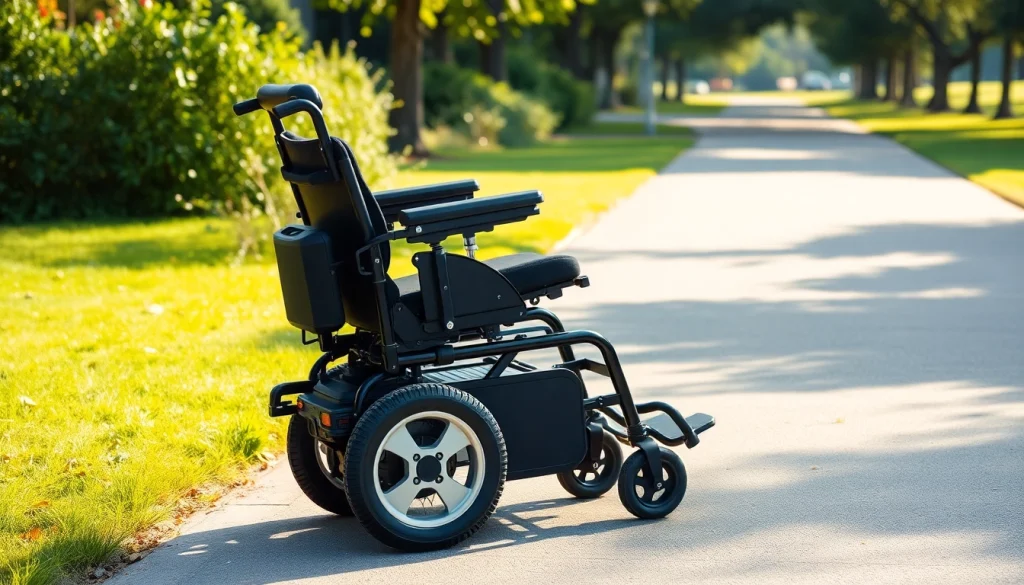Understanding Electric Wheelchairs
What is an Electric Wheelchair?
An electric wheelchair, often referred to as a power wheelchair, is a mobility device equipped with an electric motor and battery system designed to assist individuals with mobility impairments. Unlike traditional manual wheelchairs, which require physical effort to propel, electric wheelchairs are powered by rechargeable batteries that enable users to move effortlessly from one place to another. This enhanced mobility solution makes them an essential tool for individuals with limited strength, endurance, or coordination.
Key Features and Benefits of Electric Wheelchairs
Electric wheelchairs are designed with various features that enhance user experience, safety, and comfort. Some key features include adjustable seating, joystick control, and a range of speed settings, allowing for a customized mobility experience. Electric wheelchairs typically come equipped with larger wheels, enabling better outdoor and all-terrain access compared to manual alternatives.
The benefits of using an electric wheelchair extend beyond mere mobility. Many users report enhanced independence, improved social interaction, and access to activities that were previously challenging. These systems also offer opportunities for personalization, helping to cater specifically to the user’s needs, whether for indoor or outdoor use.
Difference Between Manual and Electric Wheelchairs
The most significant difference between manual and electric wheelchairs lies in their propulsion mechanism. Manual wheelchairs require users to propel themselves using their arms or have someone assist them, which can be physically demanding, especially over extended periods or distances.
In contrast, electric wheelchairs, powered by battery-operated motors, allow users to navigate their environments with minimal physical effort. This distinction has profound implications for users with limited strength, enabling them to transition to a more independent lifestyle. Furthermore, electric wheelchairs often have advanced features, such as tilt, recline, and elevation options, which are less common in manual designs.
Choosing the Right Electric Wheelchair
Factors to Consider When Buying an Electric Wheelchair
Choosing the right electric wheelchair requires careful consideration of various factors, as this decision significantly impacts the user’s quality of life. Factors to consider include:
- Weight Capacity: Ensure the wheelchair can support the user’s weight comfortably.
- Battery Life: Look for models with sufficient battery capacity for your routine usage.
- Size and Maneuverability: Consider the user’s environment—narrow hallways and compact living spaces may require a more compact model.
- Comfort and Adjustability: The seating arrangement must be adjustable to provide maximum comfort and postural support.
- Speed and Range: Evaluate the wheelchair’s speed capabilities and the distance it can travel on a single charge.
Popular Brands and Models of Electric Wheelchairs
The market for electric wheelchairs boasts numerous brands and models, each tailored to different user needs and preferences. Some popular brands include:
- Permobil: Renowned for its high-quality and customizable electric wheelchairs, often equipped with advanced features.
- Sunrise Medical: Offers a range of models focusing on comfort and maneuverability.
- Invacare: Provides reliable electric wheelchairs that merge performance with affordability.
- Quickie: Known for innovative designs and adaptability to various terrain types.
When selecting a brand or model, it’s essential to assess user reviews and expert recommendations to find the best fit based on individual needs.
Customizing Your Electric Wheelchair
Customization is a significant advantage of electric wheelchairs, where users can modify various features to enhance their comfort and usability. Customization options may include:
- Seating Systems: Opt for specialized seats that provide additional support for posture and pressure relief.
- Control Systems: Choose joystick controls or alternative options like sip-and-puff systems for those with limited hand function.
- Accessories: Consider adding accessories like cup holders, storage bags, and adapted footrests for convenience.
Before purchasing, it is recommended to consult with healthcare professionals to identify the most suitable customizations for individual needs and preferences.
Maintenance and Care for Electric Wheelchairs
Essential Maintenance Tips for Your Electric Wheelchair
Proper maintenance of an electric wheelchair is crucial for ensuring its longevity and reliable performance. Regular maintenance tasks include:
- Battery Care: Charge the battery fully and consistently to prolong its life. Regularly check for corrosion or damage.
- Wheel and Tire Inspection: Examine tires for wear and tear, maintaining adequate pressure for optimal performance.
- Cleaning: Regularly clean the wheelchair to prevent dust accumulation and ensure components remain functional.
- Mechanismic Checks: Inspect motors, brakes, and other mechanical parts to check for pronounced wear or potential malfunction.
Common Issues and Troubleshooting for Electric Wheelchairs
Even with regular maintenance, users may encounter some common issues with electric wheelchairs. Here are troubleshooting steps for frequent problems:
- Battery Not Holding Charge: Check the battery connections and ensure that the charger is functioning correctly. In older batteries, replacement may be necessary.
- Motor Malfunction: Listen for unusual sounds when operating the chair; this could indicate a problem. Checking connections or seeking professional assessment is often recommended.
- Control Issues: If the joystick experiences inaccuracy, ensure it is clean and free from obstruction. Recalibration may be needed for some models.
When to Seek Professional Help for Electric Wheelchair Repairs
While minor issues can often be resolved independently, certain situations necessitate professional assistance. You should consider consulting a technician if:
- Electrical components are malfunctioning without any visible causes.
- The wheelchair shows signs of extensive wear or structural damage.
- Battery problems persist despite following maintenance routines.
Regular check-ups by certified professionals can forestall potential issues and enhance the wheelchair’s lifespan.
Cost and Insurance Considerations
Understanding the Cost of Electric Wheelchairs
The price of electric wheelchairs can vary widely based on features, brand, and custom options. Basic models typically start around $1,500, while high-end custom wheelchairs equipped with advanced functionalities can exceed $20,000. Additional costs may arise from specialized seating systems, accessories, or post-purchase modifications.
Insurance Coverage for Electric Wheelchairs
Insurance coverage for electric wheelchairs is often available, but understanding the specifics of your plan is essential. Medicare and many private insurance companies may cover part of the cost if the wheelchair is deemed medically necessary and prescribed by a physician. Documentation such as medical records and a detailed letter of medical necessity is often required for claims approval.
Financing Options for Electric Wheelchairs
For those without sufficient insurance coverage, various financing options can help ease the burden of purchase costs. Many wheelchair retailers offer financing plans, allowing users to pay for their electric wheelchair in manageable installments. Additionally, consider government programs, grants, or nonprofit organizations that provide financial assistance for mobility devices.
Real-Life Experiences and Testimonials
Success Stories: How Electric Wheelchairs Changed Lives
Numerous individuals have experienced transformative outcomes from using electric wheelchairs. For instance, Sarah, a woman in her sixties, struggled with mobility issues due to arthritis. After receiving her electric wheelchair, she described regaining independence: “I can finally visit my friends and participate in community activities without feeling exhausted.” Such success stories underscore how electric wheelchairs enable users to reclaim their lives.
User Reviews: Pros and Cons of Various Electric Wheelchairs
User testimonials are invaluable in evaluating the effectiveness of different models. Common pros often cited include:
- Enhanced independence and mobility.
- Comfortable seating options with customizable features.
- Battery longevity and dependability.
Conversely, some cons that users mention encompass:
- Weight of the chair, making it difficult to transport.
- Initial costs that may be prohibitive for some.
How to Get Involved in the Electric Wheelchair Community
For those who wish to connect with others in the electric wheelchair community, several opportunities are available. Online forums and social media groups offer platforms for sharing experiences, tips, and resources. Additionally, local meetups or organizations dedicated to mobility aids can provide a supportive setting for engagements and friendship formation. Joining these communities can not only enhance knowledge about electric wheelchairs but also foster relationships that contribute to a more enriching lifestyle.





